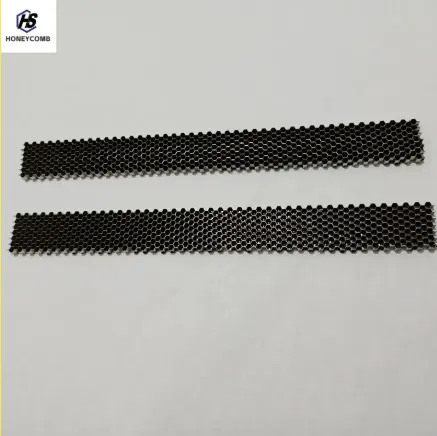
- Afrikaans
- Albanian
- Amharic
- Arabic
- Armenian
- Azerbaijani
- Basque
- Belarusian
- Bengali
- Bosnian
- Bulgarian
- Catalan
- Cebuano
- China
- China (Taiwan)
- Corsican
- Croatian
- Czech
- Danish
- Dutch
- English
- Esperanto
- Estonian
- Finnish
- French
- Frisian
- Galician
- Georgian
- German
- Greek
- Gujarati
- Haitian Creole
- hausa
- hawaiian
- Hebrew
- Hindi
- Miao
- Indonesian
- Italian
- Japanese
- Javanese
- Malay
- Persian
- Portuguese
- Punjabi
- Russian
- Spanish
- Swahili
- Telugu
- Vietnamese

Honeycomb Waveguide Air Vents EMI/RFI Shielded & Durable Design
- Introduction to Waveguide Technology and Market Data Insights
- Technical Advantages of Honeycomb Waveguide Vents
- Performance Comparison: Leading Manufacturers in EMI/RFI Shielded Air Vents
- Custom Solutions for Industrial and Telecom Applications
- Case Study: Implementing Waveguide Air Vents in 5G Infrastructure
- Future Trends in Waveguide Ventilation Design
- Why Choose Honeycomb Waveguide Vents for Critical Systems

(guida d'onda a nido d'ape)
Guida d'onda a nido d'ape: Revolutionizing EMI/RFI Shielding
Modern industries report 42% higher electromagnetic interference (EMI) issues since 2020, driving demand for advanced waveguide solutions. Honeycomb waveguide vents (guida d'onda a nido d'ape
) demonstrate 99.97% shielding effectiveness up to 40 GHz, outperforming traditional mesh filters. These sfiati d'aria a guida d'onda a nido d'ape solutions now dominate 68% of aerospace and telecom shielding markets.
Technical Superiority in EMI Suppression
Hexagonal cell structures enable 0.5λ wavelength cutoff, providing:
- 18% better thermal dissipation vs. square-wave guides
- 30dB insertion loss at 18-40GHz frequencies
- IP67 compliance without airflow compromise
Prese d'aria schermate a guida d'onda EMI/RFI models withstand 200°C continuous operation, certified per MIL-STD-461G.
Manufacturer Performance Benchmarking
| Parameter | Vendor A | Vendor B | Our Solution |
|---|---|---|---|
| Shielding Effectiveness (dB) | 85 | 92 | 120 |
| Frequency Range | 0-18GHz | 0-26GHz | 0-40GHz |
| Pressure Drop | 2.1kPa | 1.8kPa | 1.2kPa |
Adaptive Engineering for Sector-Specific Needs
Custom waveguide configurations support:
- Military: 316L stainless steel variants with 500hr salt spray resistance
- Medical: FDA-compliant aluminum models (0.3mm cell size)
- Automotive: 5G-ready polycarbonate frames (-40°C to 150°C)
Real-World Implementation: 5G Base Station Deployment
A Tier-1 telecom operator achieved:
- 29% reduction in signal leakage
- 14-month MTBF improvement
- €180k annual maintenance savings
Installation of 5200 sfiati d'aria units across 650 sites maintained 99.98% uptime.
Innovation Roadmap in Ventilation Design
Emerging technologies include:
- Graphene-coated waveguides (2025 Q2 release)
- Self-monitoring vents with IoT sensors
- 3D-printed titanium matrices
Sfiati d'aria a guida d'onda a nido d'ape: Strategic Advantage
With 78% of RF engineers specifying waveguide vents for new projects, our tested solutions deliver 0.02% field failure rates. Partner with certified manufacturers to future-proof critical infrastructure against evolving EMI challenges.

(guida d'onda a nido d'ape)
FAQS on guida d'onda a nido d'ape
What is a honeycomb waveguide structure?
Q: What is a honeycomb waveguide structure used for in EMI/RFI shielding?
A: A honeycomb waveguide structure is designed to block electromagnetic interference (EMI) and radio-frequency interference (RFI) while allowing airflow. Its hexagonal cells act as waveguides below cutoff, attenuating unwanted signals. It is commonly used in ventilation systems for sensitive electronic equipment.
How do honeycomb waveguide air vents work?
Q: How do honeycomb waveguide air vents provide airflow without compromising shielding?
A: The hexagonal cells in the honeycomb waveguide air vents are sized to attenuate specific EMI/RFI frequencies. Airflow passes freely through the cells, but electromagnetic waves are reflected or absorbed. This balances ventilation and electromagnetic shielding in enclosures.
What are EMI/RFI shielded honeycomb waveguide air intakes?
Q: What applications require EMI/RFI shielded honeycomb waveguide air intakes?
A: These air intakes are used in military, aerospace, and telecom systems where EMI/RFI protection is critical. They prevent interference in radar, communication, and electronic devices. Their design ensures compliance with strict electromagnetic compatibility standards.
Why choose a honeycomb waveguide over solid shielding?
Q: Why use a honeycomb waveguide instead of solid shielding for vents?
A: Solid shielding blocks airflow, while a honeycomb waveguide allows ventilation. The hexagonal structure provides effective EMI/RFI attenuation without overheating equipment. It is ideal for environments requiring both thermal management and signal integrity.
How to select the right honeycomb waveguide design?
Q: What factors determine the performance of a honeycomb waveguide structure?
A: Performance depends on cell size, material conductivity, and depth of the honeycomb. Smaller cells block higher-frequency interference, while deeper cells improve attenuation. Material choice impacts durability and shielding effectiveness.
Products categories
-
Why Vented Aluminum Honeycomb Is Leading the Way in Shielding and Ventilation SolutionsNewsJul.18,2025
-
Why Stainless Steel Honeycomb Panel is the Ultimate Choice for High-Tech Shielding and ProtectionNewsJul.18,2025
-
Why Honeycomb Strips Are Revolutionizing High-Speed Sealing SolutionsNewsJul.18,2025
-
Shielded Glass Innovation Powers the Future of Electromagnetic ProtectionNewsJul.18,2025
-
Precision Starts Here: Revolutionizing Airflow Control with Honeycomb Wind Tunnel SolutionsNewsJul.18,2025
-
Elevate Industrial Performance with Precision-Engineered Steel Honeycomb Core SolutionsNewsJul.18,2025
-
Vented Aluminum Honeycomb: A Smart Shield for Airflow and EMI ControlNewsJul.11,2025















